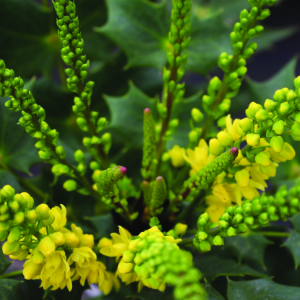
Stories from Langthorns - Mahonia
Mahonia x media 'Charity'

You might not think too much about Mahonias as they are quite a well-used plant – particularly by developers on municipal sites and new estates and they are frequently taken for granted, but that doesn’t mean we shouldn’t love them. They are easy to grow and look fantastic this time of year with bold and architectural evergreen foliage reminiscent of hollies and with gorgeous, strongly scented, yellow racemes of flowers bringing sunshine and flamboyance to the greyest day.
They are a part of the Berberis family, as is evident from their bell-shaped flowers, and they are hardy and shade tolerant - perfect for those odd corners around the house. Later in the season the nectar-rich flowers give way to purplish black berries (often with a pale grey bloom) which are popular with the birds.I love to see them growing multi-stemmed and with foliage down to the base. That can be achieved by periodic hard-pruning (after flowering) which encourages low growth and avoids that leggy look that some unpruned Mahonias are prone to.The species is named after Bernard MacMahon, an Irish horticulturalist who emigrated to America in the late eighteenth century. He developed a flourishing nursery in Philadelphia and a plant forum for the most prominent botanists and plant enthusiasts of the day, which included President Jefferson, who later entrusted to MacMahon seeds from plant collectors. The seeds included those of a plant called Berberis aquifolium “a great ornamental novelty” which had been discovered in America at the beginning of the nineteenth century (and now renamed Mahonia aquifolium). Mahonias were later discovered in Asia and the Himalayas, and they in turn have produced many hybrids.My favourite is Mahonia x media ‘Charity’ which has a slightly more graceful habit than other similar hybrids, and flowers slightly earlier, but like the others (such as ‘Winter Sun’, ‘Lionel Fortescue’ and ‘Buckland’) it has wonderfully bright, acid yellow flowers scented like lily of the valley. Its long leaves are glossy and fine, and the shrub grows to around eight feet high and wide.‘Charity’ was introduced in the 1950’s, along with Faith and Hope, from selections chosen by Sir Eric Savill, Keeper of the Gardens at the Crown Estate in Windsor. Charity has remained very popular in gardening circles whilst the other two selections have all but gone. Or as the great Oxford academic, wit and garden-writer Robin Lane Fox has said “‘Hope’ disappeared altogether in 1964 after the election of a labour government and ‘Faith’ has now dropped out of the Plant Finder.

Leave your comment
Note: HTML is not translated!